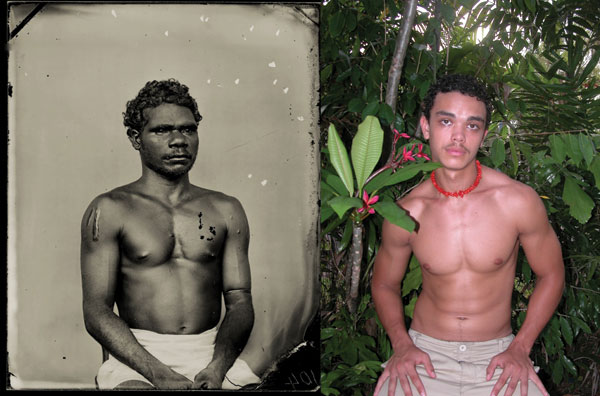Chinese men and Cinderella tell many tales
(China Daily)
Updated: 2016-08-19

Gary Lee and Sandra Hill are also presenting their art works in the exhibition YibanYiban, alongside Jason Wing, at Guangzhou's Redtory Art & Design Factory.
Lee, 62, is a Larrakia artist, born and raised in Darwin, in Australia's Northern Territory. Both his parents have ancestors with roots in Guangzhou.
For the past two decades, Lee has concentrated on photography that is centered on images of masculinity related to cultural and ethnic identities, beauty and self-projection. His China Men, a series of portraits that he captured in Beijing and Shanghai during his first tour of the Chinese mainland in 2012, is what he brings to the ongoing exhibition.
"I was keen to capture a diversity of Chinese male looks," says Lee, whose camera captured some 30 Chinese men from different walks of life, including policemen, artists and migrant workers.
The wheelchair-bound Lee ventured out to the street and requested portraits of the men, whom he randomly came across, adopting his usual street photography style.
Djon Mundine, the exhibition's illustrous curator, says that Lee has attempted to show off the looks of Chinese men, probably to counter the "Western perception" of beauty.
"It's a big thing in the West to see Chinese people as attractive, especially men," Mundine adds.
Sandra Hill, 63, a Nyungar woman from Western Australia, is also of Chinese ancestry. By combining old photographs and her paintings, she explores her family's history and the history of "Western assimilation" of Aboriginal groups.
Hill's mother was part of the "Stolen Generation", whose members were victims of the White Australia Policy. The policy came into fruition in 1901 and was progressively dismantled between 1949 and 1973.
Hill uses the fairy-tale of Cinderella to present the experiences of her mother who had assumed a "Cinderella-like persona" during her years as a domestic helper to white families.
In the meantime, the White Australia Policy reduced the number of Chinese immigrants to 12,000, according to the Melbourne-based Museum of Chinese Australian History. The number soared to 36,000 three years after the policy was officially abolished four decades ago.
As many as 866,000 Australians are of Chinese origin, according to the country's 2011 national census. Last month, an exhibition titled Bridge of Memories that was hosted at Guangzhou-based Jinan University tried to explore the story of migrants of Chinese descent who have settled in Australia in the past half century. Videos of Chinese-origin migrants telling their stories were also displayed at that show.
Jason Wing, another of the three Australian artists featured at YibanYiban, says he is proud of his country's multicultural societies.
"Australia is amazing because of our multicultural community. Cultures from around the world make Australia what it is," Wing says.
Dominic Trindade, the Australian Consul-General in Guangzhou, says that the consulate-general is supportive of such people-to-people exchanges between China and Australia. "This exhibition is part of a long-running cultural exchange between Australia and China," he says.
What we do
SAFEA is responsible for certifying foreign experts to work in the Chinese mainland and organizing overseas training for Chinese technical and managerial professionals.







